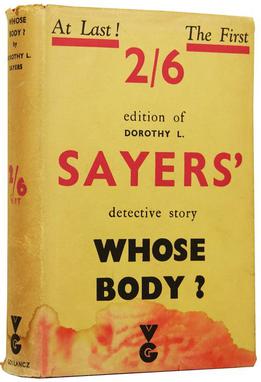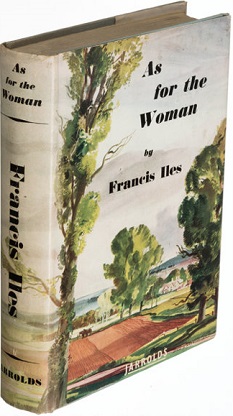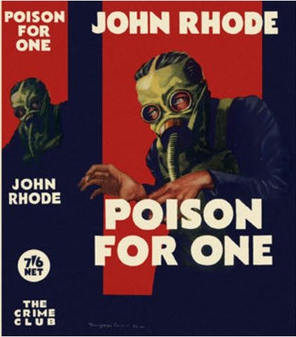
Crime fiction, detective story, murder mystery, crime novel, mystery novel, and police novel are terms used to describe narratives that centre on criminal acts and especially on the investigation, either by an amateur or a professional detective, of a crime, often a murder. Most crime drama focuses on criminal investigation and does not feature the courtroom. Suspense and mystery are key elements that are nearly ubiquitous to the genre.

Whose Body? is a 1923 mystery novel by Dorothy L. Sayers first published in the UK by T. Fisher Unwin and in the US by Boni & Liveright. It was her debut novel, and the book in which she introduced the character of Lord Peter Wimsey. Clouds of Witness (1926) would be the next novel in which the character reappears.

The Detection Club was formed in 1930 by a group of British mystery writers, including Agatha Christie, Dorothy L. Sayers, Ronald Knox, Freeman Wills Crofts, Arthur Morrison, Hugh Walpole, John Rhode, Jessie Louisa Rickard, Baroness Orczy, R. Austin Freeman, G. D. H. Cole, Margaret Cole, E. C. Bentley, Henry Wade, Constance Lindsay Taylor and H. C. Bailey. Anthony Berkeley Cox was instrumental in setting up the club, and the first president was G. K. Chesterton. There is a fanciful initiation ritual with an oath written by Sayers, and the club holds regular dinner meetings in London.

The Hollow Man is a 1935 locked room mystery novel by the American writer John Dickson Carr, featuring his recurring investigator Gideon Fell. It contains in chapter 17 the often-reprinted "locked room lecture" in which Dr Fell speaks directly to the reader, setting out the various ways in which murder can be committed in an apparently locked room or otherwise impossible situation.

The Golden Age of Detective Fiction was an era of classic murder mystery novels of similar patterns and styles, predominantly in the 1920s and 1930s. The Golden Age proper is in practice usually taken to refer to a type of fiction which was predominant in the 1920s and 1930s but had been written since at least 1911 and is still being written.
The Crime Writers' Association (CWA) is a specialist authors' organisation in the United Kingdom, most notable for its "Dagger" awards for the best crime writing of the year, and the Diamond Dagger awarded to an author for lifetime achievement. The Association also promotes crime writing of fiction and non-fiction by holding annual competitions, publicising literary festivals and establishing links with libraries, booksellers and other writer organisations, both in the UK such as the Society of Authors, and overseas. The CWA enables members to network at its annual conference and through its regional chapters as well as through dedicated social media channels and private website. Members' events and general news items are published on the CWA website, which also features Find An Author, where CWA members are listed and information provided about themselves, their books and their awards.
Kenneth Martin Edwards is a British crime novelist, whose work has won multiple awards including lifetime achievement awards for his fiction, non-fiction, short fiction, and scholarship in the UK and the United States. In addition to translations into various European languages, his books have been translated into Japanese, Chinese, Korean, and Taiwanese. As a crime fiction critic and historian, and also in his career as a solicitor, he has written non-fiction books and many articles. He is the current President of the Detection Club and in 2020 was awarded the Crime Writers' Association's Diamond Dagger, the highest honour in British crime writing, in recognition of the "sustained excellence" of his work in the genre.
The Lake District Mysteries are a series of detective novels by British crime writer Martin Edwards. The books feature Hannah Scarlett and the historian Daniel Kind, and are the first series of crime novels by a British detective novelist to be set in the Lake District, a region in North-West England.
Ernest Carpenter Elmore was an English theatre producer and director, and writer of crime and fantasy novels. He wrote his crime novels under the pseudonym John Bude.

Smallbone Deceased is a 1950 mystery novel by the English author Michael Gilbert, published in the United Kingdom by Hodder and Stoughton and in the United States by Harper & Brothers. A practising lawyer himself, Gilbert made the setting of the novel a London solicitor's office. The book was Gilbert's fourth novel and, like his three earlier ones, features Chief Inspector Hazlerigg. The novel was well-received and has regularly appeared in "Top 100" crime lists. Some critics consider it to be Gilbert's best work.

The Rising of the Moon is a 1945 mystery detective novel by the British writer Gladys Mitchell. It is the eighteenth in her long-running series featuring the psychoanalyst and amateur detective Mrs Bradley. It has been described as one of the best of Mitchell's novels.

Laurels Are Poison is a 1942 mystery detective novel by the British writer Gladys Mitchell. It is the fourteenth in her long-running series featuring the psychoanalyst and amateur detective Mrs Bradley. It was Mitchell's own favourite among her novels and has been considered her best by other critics. It introduced the character of Laura Menzies who became recurring assistant of Mrs Bradley in subsequent novels.

Tracks in the Snow is a 1906 detective novel by the British writer and politician Godfrey Benson. It was his only crime novel, he later became better known for his non-fiction works such as biographies of Abraham Lincoln (1916) and Theodore Roosevelt (1923). A popular success, it was republished in 1928, but it later fell into obscurity. Martin Edwards included it in his list of a hundred classic crime novels and noted "Benson's thoughtful, well-crafted prose, his insights into human behaviour, and the way in which the story touches on issues such as free will and the ramifications of Britain's imperial past combine to make his brief venture into the crime genre notable".

The Luck of the Vails is a 1901 mystery crime novel by the British writer E. F. Benson, later better known as the author of the Mapp and Lucia series. It was one of only two ventures he made into the genre during his prolific career along with The Blotting Book (1908). In his autobiography Benson numbered it as one of only four of his novels he was satisfied with.

Cicely Disappears is a 1927 mystery novel by the British writer Anthony Cox, written under the pen name of A. Monmouth Platts. Cox used a variety of pseudonyms during his career, in this case based on two properties he was associated with in Watford. Cox had enjoyed success with novels featuring his private detective Roger Sheringham, at first published anonymously, and also wrote a number of stand-alone novels such as this one.

As for the Woman is a 1939 novel by the British writer Anthony Berkeley, written under the pen name of Francis Iles. It was the final novel of Berkeley, a key writer of the Golden Age of Detective Fiction, as he concentrated on reviewing after this point. He later told fellow writer John Dickson Carr that he produced the book during a period of great emotional strain and that its poor commercial and critical reception affected him badly. Thereafter he turned down all offers to write further novels. Although two further novels under the Iles name were announced by the publisher, neither of them were ever released.

Shot at Dawn is a 1934 detective novel by John Rhode, the pen name of the British writer Cecil Street. It is the nineteenth in his long-running series of novels featuring Lancelot Priestley, a Golden Age armchair detective.

Poison for One is a 1934 detective novel by John Rhode, the pen name of the British writer Cecil Street. It is the eighteenth in his long-running series of novels featuring Lancelot Priestley, a Golden Age armchair detective. It combines elements of the locked room mystery and country house mystery.

The Robthorne Mystery is a 1934 detective novel by John Rhode, the pen name of the British writer Cecil Street. It is the seventeenth in his long-running series of novels featuring Lancelot Priestley, a Golden Age armchair detective. It was published in the United States the same year by Dodd Mead.

A Telegram from Le Touquet is a 1956 detective novel by the British writer John Bude. It is part of a series featuring Superintendent Meredith of Scotland Yard, although he only appears at the end of the book The central detective is Inspector Blampignon of the Sûreté who had previously appeared in Death on the Riviera. It is divided into two distinct parts with the first section narrated in first person by Nigel Derry, one of the suspects, and the second part follows the investigations of the French police. In 2024 it was republished as part of the British Library Crime Classics series.
















